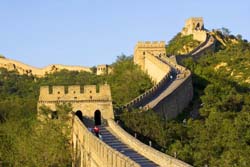|

Gubeikou section of the Great Wall is on the north of Tiger Mountain, which has in it an indentation one meter in diameter and 20 cm deep called the Spring of Heaven. The water from this spring flows continuously in both the rainy and fry seasons. Near the spring is a defense tower called the Five Eyes Tower. Unique in design, the body of the tower is made of rectangular stone blocks and the roof of polished bricks. Inside there are two large barrel-vaulted ceilings, three corridors, 10 arched openings and a central octagonal dome supported by four brick columns arranged in a square. The stone columns are decorated with relief carvings of flowers, which add a touch of elegance to this otherwise austere building. Standing atop this tower, one can see the Great Wall winding its way along the contours of the mountains. From this vantage point, the wall appears like a ribbon of jade linking the Wuling Mountain (the highest peak of the Yanshan Range) with the Sleeping Tiger Range near Gubeikou.
Leaving the Five Eyes Tower and proceeding along the wall, one comes to the Tower for Viewing the Capital (Wangjinglou), which sits at a strategic point in Tiger Mouth Peak. The tower commands a panoramic view of the surrounding countryside. Off to the southwest, the mirror-like surface of Miyun Reservoir appears, the outline of Beijing can be seen in the early morning and the city lights become visible at night.
Gubeikou is 125 kilometers away from Beijing proper. It has long been a town of military significance and an important passage to the capital city. The Yanshan Range winds from east to west and is cut off at Gubeikou, forming a natural narrow pass here.
To the west of the pass are the Chaohe River and the Wohu Mountain, and to the east is the Panlong Mountain. From ancient times, Gubeikou has served as a route of strategic importance, linking the southern and northern areas of the YanshanRange. As early as 2,500 years ago, a fortification was built here and was constantly reinforced throughout the following dynasties.
The main part of today's Gubeikou Wall was constructed under the supervision of Xu Da, a noted general in the Ming Dynasty. It runs for more than 20 kilometers and consists of four sections: Wohushan, Panlongshan, Jinshanling, and Simatai. It has 143 beacon towers, each positioned at an average interval of 156 meters. The nearest two are only 30 meters apart. The inside of these towers varies in design. While some have a flat ceiling, others either have an arched ceiling, a domed ceiling, or an octagonal, painted ceiling. Each tower has two floors, six archways, and ten arched doors, allowing garrisoned soldiers to advance and retreat freely. The towers are also different in size. The largest one can accommodate a garrison of 100 soldiers, and the smallest one a garrison of 10 soldiers. The towers often have one to six portholes.
Different sections of Great Wall
Badaling Great Wall Mutianyu Great Wall Huangyaguan Great Wall Jinshanling Great Wall Simatai Great Wall Juyongguan Great Wall Jiayuguan Great Wall Overhanging Great Wall
The Great Wall was built with dirt, stone and bricks. At the top of the Great wall, a roadway paved with three layers of brick connected the watchtowers. The roadways are wide enough to hold ten soldiers side by side. Trekking on Great Wall offers an interesting climb and great views, it can be quite exhausting to reach the top. Nevertheless, if possible, try to avoid going on a national holiday or at the weekend.
3 D virtural tour of Great Wall Blog articles of trekking on Great Wall
|
|